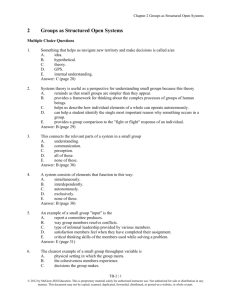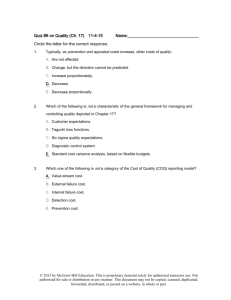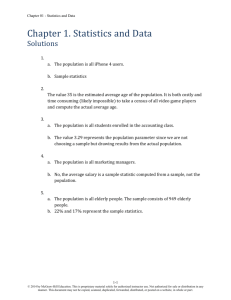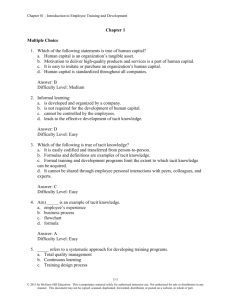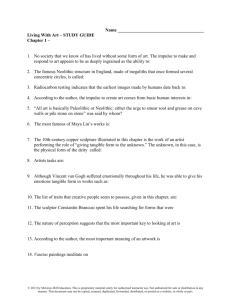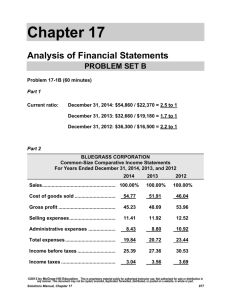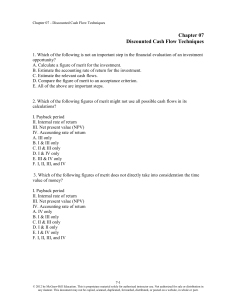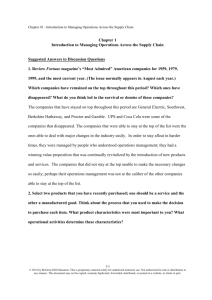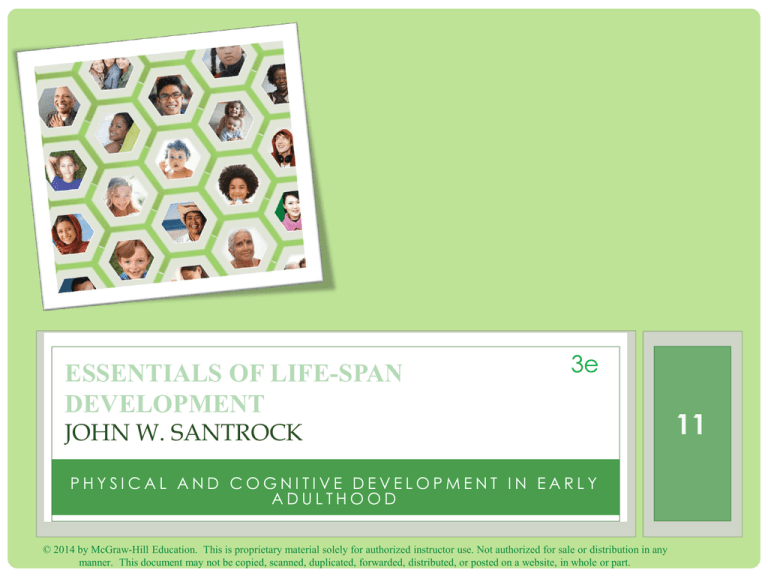
ESSENTIALS OF LIFE-SPAN
DEVELOPMENT
3e
JOHN W. SANTROCK
PHYSICAL AND COGNITIVE DEVELOPMENT IN EARLY
ADULTHOOD
© 2014 by McGraw-Hill Education. This is proprietary material solely for authorized instructor use. Not authorized for sale or distribution in any
manner. This document may not be copied, scanned, duplicated, forwarded, distributed, or posted on a website, in whole or part.
11
CHAPTER OUTLINE
•
•
•
•
•
The transition from adolescence to adulthood
Physical development
Sexuality
Cognitive development
Careers and work
© 2014 by McGraw-Hill Education. This is proprietary material solely for authorized instructor use. Not authorized for sale or distribution in any
manner. This document may not be copied, scanned, duplicated, forwarded, distributed, or posted on a website, in whole or part.
11-2
THE TRANSITION FROM ADOLESCENCE
TO ADULTHOOD
• Becoming an adult
• The transition from high school to college
© 2014 by McGraw-Hill Education. This is proprietary material solely for authorized instructor use. Not authorized for sale or distribution in any
manner. This document may not be copied, scanned, duplicated, forwarded, distributed, or posted on a website, in whole or part.
11-3
THE TRANSITION FROM ADOLESCENCE
TO ADULTHOOD
• Becoming an adult
• Emerging adulthood: Transition from adolescence to
adulthood
• Occurs from approximately 18 to 25 years of age
• Characterized by experimentation and exploration
• Key features
• Identity exploration, especially in love and work
• Instability, self-focused, and feeling in-between
• The age of possibilities, a time when individuals have an
opportunity to transform their lives
© 2014 by McGraw-Hill Education. This is proprietary material solely for authorized instructor use. Not authorized for sale or distribution in any
manner. This document may not be copied, scanned, duplicated, forwarded, distributed, or posted on a website, in whole or part.
11-4
THE TRANSITION FROM ADOLESCENCE
TO ADULTHOOD
• Markers of becoming an adult
• Holding a full-time job
• Economic independence
• Taking responsibility for oneself
• The transition from high school to college
•
•
•
•
Top-dog phenomenon
Movement to a larger school structure
Increased focus on achievement and assessment
Several positive features
© 2014 by McGraw-Hill Education. This is proprietary material solely for authorized instructor use. Not authorized for sale or distribution in any
manner. This document may not be copied, scanned, duplicated, forwarded, distributed, or posted on a website, in whole or part.
11-5
PHYSICAL DEVELOPMENT
• Physical performance and development
• Health
© 2014 by McGraw-Hill Education. This is proprietary material solely for authorized instructor use. Not authorized for sale or distribution in any
manner. This document may not be copied, scanned, duplicated, forwarded, distributed, or posted on a website, in whole or part.
11-6
PHYSICAL DEVELOPMENT
• Physical performance and development
• Peak physical performance typically occurs between 19
and 26
• Muscle tone and strength usually begin to show signs of
decline around age 30
© 2014 by McGraw-Hill Education. This is proprietary material solely for authorized instructor use. Not authorized for sale or distribution in any
manner. This document may not be copied, scanned, duplicated, forwarded, distributed, or posted on a website, in whole or part.
11-7
PHYSICAL DEVELOPMENT
• Health
• Emerging adults have twice the mortality rate of
adolescents
• Few chronic health problems
• Increase in bad health habits
• Eating and weight
• Obesity - Linked to increased risk of hypertension, diabetes, and
cardiovascular disease
• Dieting - Become an obsession with many Americans
• Although obesity is on the rise
© 2014 by McGraw-Hill Education. This is proprietary material solely for authorized instructor use. Not authorized for sale or distribution in any
manner. This document may not be copied, scanned, duplicated, forwarded, distributed, or posted on a website, in whole or part.
11-8
PHYSICAL DEVELOPMENT
• Regular exercise
• Helps prevent chronic disorders
• Aerobic exercise: Sustained exercise that stimulates heart and
lung activity
• Exercise benefits both physical and mental health
• Improves self-concept and reduces anxiety and depression
• Substance abuse
• Alcohol
• Binge drinking - Increases in college
• Pregaming - Drinking alcohol before going out common among
college students
© 2014 by McGraw-Hill Education. This is proprietary material solely for authorized instructor use. Not authorized for sale or distribution in any
manner. This document may not be copied, scanned, duplicated, forwarded, distributed, or posted on a website, in whole or part.
11-9
SEXUALITY
•
•
•
•
Sexual activity in emerging adulthood
Sexual orientation and behavior
Sexually transmitted infections
Forcible sexual behavior and sexual harassment
© 2014 by McGraw-Hill Education. This is proprietary material solely for authorized instructor use. Not authorized for sale or distribution in any
manner. This document may not be copied, scanned, duplicated, forwarded, distributed, or posted on a website, in whole or part.
11-10
SEXUALITY
• Sexual activity in emerging adulthood
• Patterns of heterosexual behavior:
• Males have more casual sexual partners, while females report
being more selective
• Casual sex is more common in emerging adulthood than in
young adulthood
© 2014 by McGraw-Hill Education. This is proprietary material solely for authorized instructor use. Not authorized for sale or distribution in any
manner. This document may not be copied, scanned, duplicated, forwarded, distributed, or posted on a website, in whole or part.
11-11
SEXUALITY
• Sexual orientation and behavior
• Heterosexual attitudes and behavior
• Americans fall into three categories:
• 1/3 have sex twice a week or more, 1/3 a few times a month, and
1/3 a few times a year or not at all
• Married (and cohabiting) couples have sex more often than
non-cohabiting couples
• Most Americans do not engage in kinky sexual acts
• Adultery is the exception rather than the rule
• Men think about sex far more often than women do
© 2014 by McGraw-Hill Education. This is proprietary material solely for authorized instructor use. Not authorized for sale or distribution in any
manner. This document may not be copied, scanned, duplicated, forwarded, distributed, or posted on a website, in whole or part.
11-12
SEXUALITY
• Sources of sexual orientation
• Sexual orientation is a continuum from exclusive male–female
relations to exclusive same-sex relations
• Most likely a combination of genetic, hormonal, cognitive, and
environmental factors
© 2014 by McGraw-Hill Education. This is proprietary material solely for authorized instructor use. Not authorized for sale or distribution in any
manner. This document may not be copied, scanned, duplicated, forwarded, distributed, or posted on a website, in whole or part.
11-13
SEXUALITY
• Attitudes and behavior of lesbians and gay males
• Many gender differences that appear in heterosexual
relationships occur in same-sex relationships
• Lesbians and gays experience life as a minority in a dominant,
majority culture
• Developing a bicultural identity creates new ways of defining
themselves
© 2014 by McGraw-Hill Education. This is proprietary material solely for authorized instructor use. Not authorized for sale or distribution in any
manner. This document may not be copied, scanned, duplicated, forwarded, distributed, or posted on a website, in whole or part.
11-14
SEXUALITY
• Sexually transmitted infections (STIs): Diseases
contracted primarily through sex
• Effective strategies for protecting against HIV
•
•
•
•
Know your risk status and that of your partner
Obtain medical examinations
Have protected, not unprotected, sex
Do not have sex with multiple partners
© 2014 by McGraw-Hill Education. This is proprietary material solely for authorized instructor use. Not authorized for sale or distribution in any
manner. This document may not be copied, scanned, duplicated, forwarded, distributed, or posted on a website, in whole or part.
11-15
FIGURE 11.6 - SEXUALLY TRANSMITTED
INFECTIONS
© 2014 by McGraw-Hill Education. This is proprietary material solely for authorized instructor use. Not authorized for sale or distribution in any
manner. This document may not be copied, scanned, duplicated, forwarded, distributed, or posted on a website, in whole or part.
11-16
SEXUALITY
• Forcible sexual behavior and sexual harassment
• Rape: Forcible sexual intercourse with a person who does
not consent to it
• Characteristics of male rapists
• Aggression enhances their sense of power or masculinity
• Angry at women in general
• Want to hurt and humiliate their victims
• Date or acquaintance rape: Coercive sexual activity
directed at someone with whom the perpetrator is at least
casually acquainted
© 2014 by McGraw-Hill Education. This is proprietary material solely for authorized instructor use. Not authorized for sale or distribution in any
manner. This document may not be copied, scanned, duplicated, forwarded, distributed, or posted on a website, in whole or part.
11-17
SEXUALITY
• Sexual harassment - Manifestation of power of one person
over another
• Takes many forms
© 2014 by McGraw-Hill Education. This is proprietary material solely for authorized instructor use. Not authorized for sale or distribution in any
manner. This document may not be copied, scanned, duplicated, forwarded, distributed, or posted on a website, in whole or part.
11-18
COGNITIVE DEVELOPMENT
• Cognitive stages
• Creativity
© 2014 by McGraw-Hill Education. This is proprietary material solely for authorized instructor use. Not authorized for sale or distribution in any
manner. This document may not be copied, scanned, duplicated, forwarded, distributed, or posted on a website, in whole or part.
11-19
COGNITIVE DEVELOPMENT
• Cognitive stages
• Piaget’s view:
• Adolescents and adults think qualitatively in the same way
• Individuals consolidate their formal operational thinking during
adulthood
• Postformal thought:
•
•
•
•
Reflective, relativistic, and contextual
Provisional
Realistic
Recognized as being influenced by emotion
© 2014 by McGraw-Hill Education. This is proprietary material solely for authorized instructor use. Not authorized for sale or distribution in any
manner. This document may not be copied, scanned, duplicated, forwarded, distributed, or posted on a website, in whole or part.
11-20
COGNITIVE DEVELOPMENT
• Creativity
• Early adulthood is a time of great creativity for some people
• Any consideration of decline in creativity with age requires
consideration of the field of creativity involved
© 2014 by McGraw-Hill Education. This is proprietary material solely for authorized instructor use. Not authorized for sale or distribution in any
manner. This document may not be copied, scanned, duplicated, forwarded, distributed, or posted on a website, in whole or part.
11-21
CAREERS AND WORK
• Careers
• Work
© 2014 by McGraw-Hill Education. This is proprietary material solely for authorized instructor use. Not authorized for sale or distribution in any
manner. This document may not be copied, scanned, duplicated, forwarded, distributed, or posted on a website, in whole or part.
11-22
CAREERS
• Developmental changes
• From mid-twenties on, individuals often seek to establish
their emerging career in a particular field
• Finding a path to a purpose
• Only 20% of 12 – 22-year-olds had a clear vision of where
they want to go in life
• Students focus only on short-term goals
• Don’t explore the big, long-term picture of what they want to
do in life
© 2014 by McGraw-Hill Education. This is proprietary material solely for authorized instructor use. Not authorized for sale or distribution in any
manner. This document may not be copied, scanned, duplicated, forwarded, distributed, or posted on a website, in whole or part.
11-23
WORK
• The impact of work
• Most spend 1/3 of their lives at work
• Important consideration is how stressful the work is
• Work during college
• Working can pay or help offset some costs of schooling
• But can also can restrict students’ opportunities to learn
© 2014 by McGraw-Hill Education. This is proprietary material solely for authorized instructor use. Not authorized for sale or distribution in any
manner. This document may not be copied, scanned, duplicated, forwarded, distributed, or posted on a website, in whole or part.
11-24
WORK
• Monitoring the occupational outlook
• Be knowledgeable about different fields and companies
• Unemployment
• Produces stress regardless of whether the job loss is
temporary, cyclical, or permanent
• Factors affecting employment
• Physical problems, mental problems, marital difficulties, and
homicide
© 2014 by McGraw-Hill Education. This is proprietary material solely for authorized instructor use. Not authorized for sale or distribution in any
manner. This document may not be copied, scanned, duplicated, forwarded, distributed, or posted on a website, in whole or part.
11-25
CAREERS AND WORK
• Dual-earner couples
• Face special challenges finding a balance between work
and family life
• Diversity in the workplace
• Women have increasingly entered the labor force
• Ethnic diversity also increasing in the workplace in almost
every developed country
© 2014 by McGraw-Hill Education. This is proprietary material solely for authorized instructor use. Not authorized for sale or distribution in any
manner. This document may not be copied, scanned, duplicated, forwarded, distributed, or posted on a website, in whole or part.
11-26

